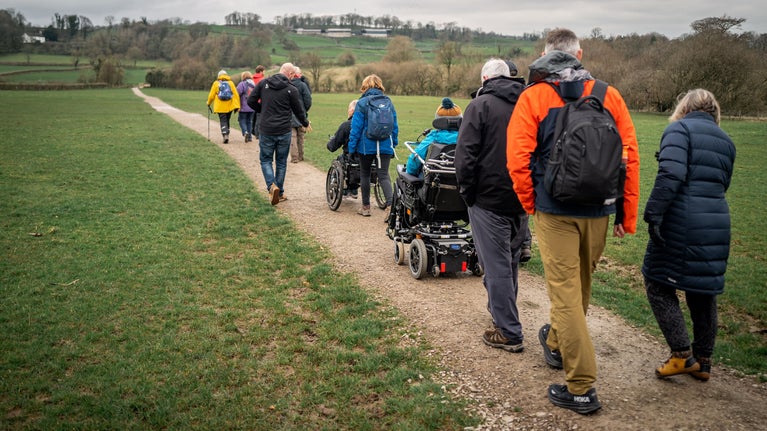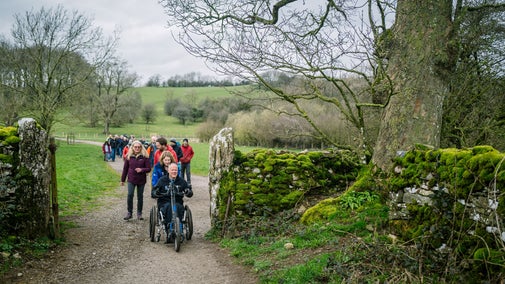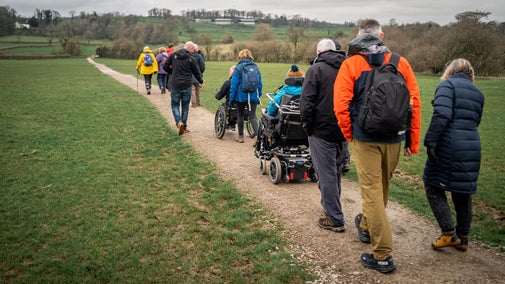Cecilia's ramp

Learn more about our plans to reopen an early 19th century access ramp, named after its original user Cecilia Strickland.
Improving access at Sizergh
We’re proud of the work we do towards improving access for all across Sizergh's 800-year-old estate, house and garden. Last March, we launched the Holeslack Accessible Trail, running through beautiful ancient woodland and historic farmland. Now we’re turning our attention to plans for an access project throughout the gardens, with an exciting connection into the manor house. We're planning to reopen an early 19th century access ramp, known as Cecilia’s ramp, to provide access for all to Sizergh’s first floor, with a network of accessible paths to widen access across the historic gardens for all.
Making Cecilia proud
This project is one close to our hearts, telling part of the story of a notable figure in Sizergh's long history, which now spans 30 generations. Cecilia Strickland (1741-1814) was heiress to the significant Lancashire estates of Standish and Borwick. She married not once but twice into the Strickland family – first Charles, who died in 1770, and then, in 1779, his first cousin Jarrard Strickland of York. The children of these two marriages are now referred to as the ‘senior’ and ‘junior’ lines of the family, with both sides playing their part in the fate of Sizergh.
Later in life, Cecilia suffered from rheumatism, and had to make use of a very early model of a wheelchair. With small wheels attached to a simple armed chair, she referred to her aid as a ‘chariot’ and – in an example of enlightened forward thinking – arranged to have a ramp built into the grounds to allow her to continue accessing the gardens. This ramp was constructed in the early 1800s, along with converting the Queens Room into Cecilia’s bedroom, and lowering her bed to the level of the wheeled chair.
For some time pass’d I have been growing worse & my limbs so stiff & uneasily swelled that every thing is a trouble to me; yet some Stirring either by my own Exertions or help of other people is so necessary...
Cecilia's ramp
Following Cecilia’s death in 1814, the ramp became a flowerbed, and now our plan is to reinstate it. Our ambition is to restore first floor access to the House for our visitors with limited mobility, which links to a new network of accessible paths for all throughout the gardens.
Down the garden path
We currently limit access to the garden throughout the winter to prevent lawn damage. Along with this, the lack of appropriate footpaths through the south lawn, Dutch Garden and around the Mirror Pond means that even during the summer months, access can be difficult for some of our visitors. So, we want to create a circular, fully accessible, and inclusive path around the garden - suitable for all users. We'll also add seating, to make sure there are more places to take in the views.
Other plans
Other important parts of this project to improve access are
- A new home for our trampers within a covered solar charging station with space for 20 bikes
- Installing a free to access modular changing place, close to our desginated disabled parking bays
Support us
Thanks to a generous gift in will from the family of John Gordon Cooper, we have some funding in place to support the design process. We are now actively fundraising to secure a budget to build the ramp structure, and to lay the garden paths.
Contact us

Visiting the garden at Sizergh
Feel inspired with a stroll through the gardens at Sizergh and find out what you’re likely to see growing here when you visit.

Access at Sizergh | Lake District
We want to make sure that Sizergh is accessible for all visitors. The historic house, gardens and estate we care for present challenges in creating access for all, but we are taking steps to ensure that as many people as possible are able to experience Sizergh’s history and beauty. Here you’ll find information about access across the different areas of Sizergh and how to make the most of your visit.

Borrow a mobility scooter to explore the garden and estate
Hire a tramper mobility scooter at Sizergh to assist your visit to the gardens in Kendal, Cumbria.

Holeslack Accessible Trail
Take this accessible circular route for a flavour of the Sizergh estate, from ancient woodlands and traditional Westmorland orchards to historic farm buildings and parklands.



